Tue, 13 May 2014
A Collapsed Dam
Last weekend we went to Jizerské hory, and we have visited an interesting technological sight there: the collapsed dam on the Desná river. Here are my photos together with a short description, as it apparently does not have its own English Wikipedia page, just a dead link from the Desná disambiguation page. More can be read in the Czech Wikipedia (Přehrada Desná).
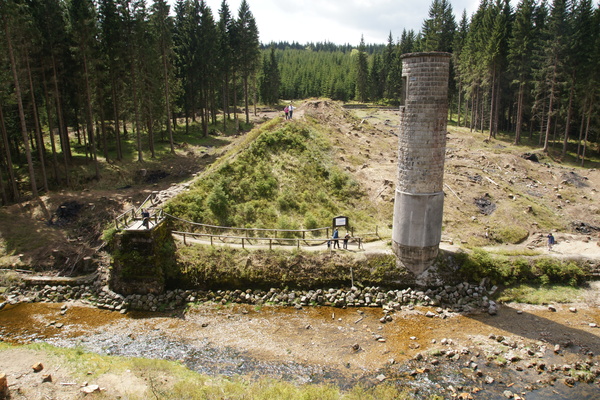
The dam collapsed less than year after being built, in 1916. The forest workers spotted a tiny leak, and informed the dam keeper, who in turn informed his supervisor, and was given a permission to open the slide valves. In spite of this, the dam collapsed in about 70 minutes. The resulting flood wave killed 62 people. In the picture, there is the dam body from the side, together with the valve tower, and the river Desná flowing to the left through the gap in the dam.
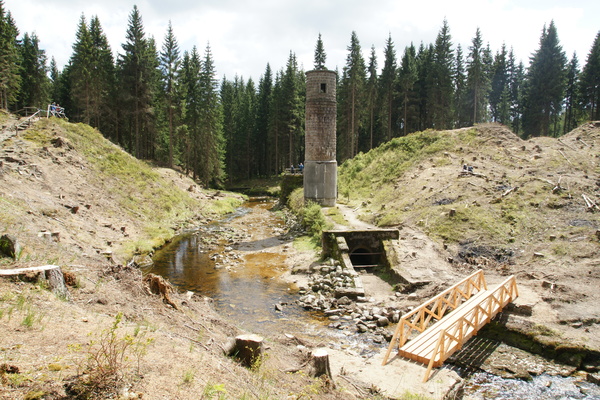
The view down the river shows the huge gap where the part of the dam collapsed. Behind the new wooden bridge the entry to the water outlet tunnel can be seen.
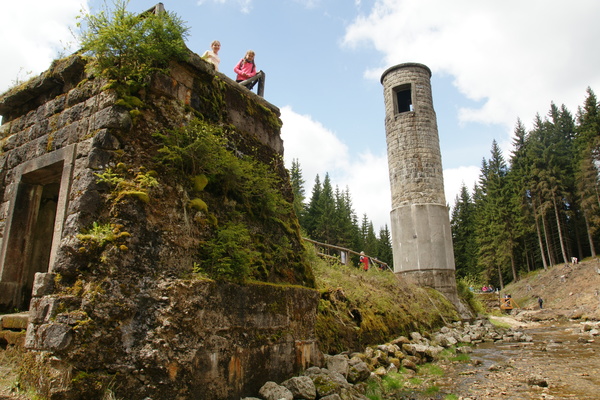
The outlet chamber and the valve tower. There were two slide valves in the dam: one in the tower, and the second one in the outlet chamber. When the dam started to leak, the first valve was fully open, while the second one was half-open.
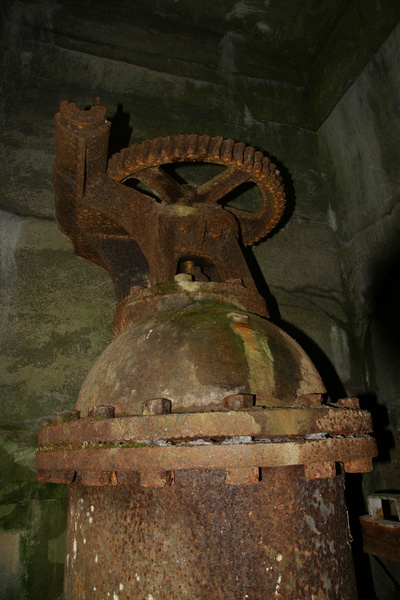
The second slide valve. After being informed about the leak, the dam keeper tried to fully open also the second valve, but he was forced to flee from the valve chamber in order to save his life. The valve has remained open at about 75 %.
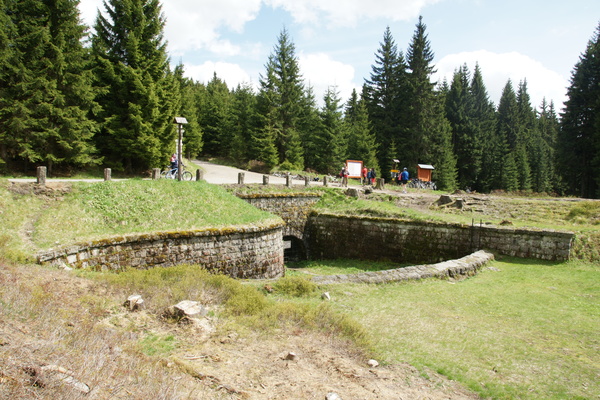
In times of torrential rains, it was possible to divert part of the incoming water to the neighbouring dam Souš by a tunnel more than one kilometer long. Nowadays, the tunnel is closed, as it is a nature reserve of bat wintering.
Here is a modern analysis of the catastrophe and the reasons of the failure of the dam (in Czech, sorry).
An interesting fact about the political and economical system of that time: this dam and several others in Jizerské hory were built by a non-profit organization (Vodní družstvo, in English something like Water co-operative), formed by local works owners and other local persons and organizations, which were endangered by annual floods from the mountain rivers. The local people paid for the whole system of dams. I wonder why we pay enormous taxes and then build anti-flood infrastructure using the money from Brussels. I would guess the percentage of money lost in this process is huge compared to what our forefathers did.
Wed, 29 May 2013
E-shop Reviews
Apparently at Mall.cz they think that they sell only perfect goods, and don't want people to write negative reviews to some of the goods, even though the description contains plain lies. As an example, we take this 9V rechargable battery. In the description, they say:
The rechargable NiMH battery from GP Batteries lasts up to 5 times longer than alkaline batteries [...]
There has to be some serious magic used by either Mall.CZ or GP Batteries, which causes that the battery rated at 8.4 V with 200 mAh capacity lasts five times longer than an ordinary 9V primary alkaline cell. Apparently the later according to Wikipedia has 565 mAh capacity, and thus stores three times more energy than the rechargable batery from GP Batteries.
I have written a comment along these lines to the Mall.CZ system on May 7th, but it is still not published as of now. So beware of any e-shop which doesn't allow negative comments, such as Mall.CZ. It is interesting that some bigger shops like DX are perfectly OK with people writing negative reviews to some of their goods.
Thu, 25 Apr 2013
Re: The Shared Office Printer
PHD comics is as funny as always. What I consider interesting is the last problem - printing on a special paper (a.k.a. the "Print Sprint"). I solve this problem differently:
Usually, such a print job is single-page only. So the easiest solution is to use the manual feed input. Open the manual input tray, print your job with manual tray specified, return to the printer, and feed your special paper into the manual input tray. People usually don't specify the manual tray as input.
Another alternative is when I don't want to research (again) how to print
using the manual input tray from the command line. I run something like
"sleep 60; lpr myfile", walk to the printer, open the default
tray and manual input tray, wait a moment, and when the print job arrives,
just select the manual tray from the front panel of the printer.
Of course it heps if CUPS together with the printer can cooperate enough to display at least the print job name (including the hostname) or even the job owners' login name, to be sure that it is really my print job. How do you print on a special paper on shared office printers?
Thu, 11 Feb 2010
Web Comics Dying?
Is it just an unfortunate coincidence, or are several web comics sites slowly dying?
For example, Order of the Stick is updated only every two weeks or so, User Friendly runs repeated strips for about a year now, and even BOFH has not been updated since last December, and had only 17 stories last year.
Did the authors manage to get a real life finally? Or have they been swallowed by the Internet black hole which is Facebook?
Wed, 20 Jan 2010
Wikipedia Warning
Warning: idling at Wikipedia can be dangerous, as it can destroy your image of completely innocent things forever.
For example, that nice, melodic, and gentle Paul McCartney's song "Mull of Kintyre" will never be the same again for me (click on your own responsibility).
Thu, 29 Jan 2009
Questionable Content
When browsing the Web, one can often find a content, which is - how to say it - questionable. Recently I have found an excellent example of it :-)
 Questionable Content is a web comic written by Jeph Jacques. It is not only interesting and funny, but it also
contains humanoid robots, lots of rock music references (not that
I get most of those), occasional anime references, and the highest proportion of
characters with mental disorders from all the web comic strips. The only
annoying part is occasional filler strips and guest strips. But on the
other hand, it is actually released five times a week (unlike the
Order of the Stick these days).
Questionable Content is a web comic written by Jeph Jacques. It is not only interesting and funny, but it also
contains humanoid robots, lots of rock music references (not that
I get most of those), occasional anime references, and the highest proportion of
characters with mental disorders from all the web comic strips. The only
annoying part is occasional filler strips and guest strips. But on the
other hand, it is actually released five times a week (unlike the
Order of the Stick these days).
For a light intro you can read for example the story arc beginning in the strip #1322 from a week ago. Or start from the beginning. Favourite character? Hannelore the obsessive-compulsive disorder, of course. Go forth and waste your time :-)
Wed, 10 Dec 2008
Ebooks and Copyright
Just a pointer to two interesting blog posts I have just read: Ted Ts'o discusses the ethical problem of wanting an e-book version of something which is out of print for a long time, and also has an interesting follow-up in which he discusses whether copyright is a matter of money (like most books or films) or control (like in some software, especially many copylefts like GPL). So what do you think about handling rights for the work which is abandoned for a long time, or simply which is not available in your local part of the timespace? And should rights for "static" work like books, music, films, photos, etc. be handled differently than rights for things which can be improved by further work of other people (like software)?
Tue, 18 Nov 2008
Without Visa?
Today's newspapers are full of articles commenting the fact that Czech citizens now can travel to the U.S. without visa, and taking it as a big achievement of Czech politicians. Having gone through the U.S. visa procedure myself recently, I wonder why no journalist pointed out the sad truth, that in fact, the visa procedure is still there.
The meaning of the phrase "not needing visa" for me is being able to decide to cross the border at any time in any country, and equipped just with the passport being able to appear in front of the passport officer, who in turn should immediately be able to decide whether to allow me in or not (possibly asking some trivial questions like whether I want to work in his country or in which hotel I want to stay).
But the current procedure is still the same visa procedure as before (including lots of big-brotherish questions and gathering of personal data). The only differences are that it takes only three days to validate the request instead of a month, it can be filled in online instead of in the U.S. embassy, and it requires a biometric passport (big brother again). And probably the immigration clerk would check the passengers without visa more thoroughly (at least this is how it has been a month ago when I travelled to Portland).
So nothing to see here (definitely no material for the front pages of the newspapers), move along.
Fri, 17 Oct 2008
Stitching Photos
In Oregon, I took several photos from one point in order to try to stitch them to one panorama later. The shots were taken from hand, so it was not optimal. In further experiments I would have to use a wider angle lens and higher overlap of the frames (I used about 20 % on each side). Manual exposition and focus is a necessity in order to get the same level of light across the whole view.

The image above is composed from eight photos taken at the Crown Point above the Columbia River. Best viewed using two wide monitors in Xinerama/XRandr dual mode :-)
The image has been created using Hugin, which is a really nice and intuitive software. I have been able to create the panorama without even reading the manual. Altough, reading their tutorials definitely helps (a funny bug there - the tutorial section labeled "Czech/Čeština" contains only one tutorial, which is actually in Slovak :-).
Stitching photos is another ugly case of software patents abuse: the algorithm for automatically detecting suitable alignment control points is patented in the U.S., which means that even though the patent is definitely not valid in Europe, precompiled software distributed globally (like Hugin) cannot use it.
Thu, 16 Oct 2008
Driving in the United States
I will not write about everything I did in Oregon (you can get better insight to the way of life in the US from the point of view of a foreigner in a Linus' blog), but there is one pretty interesting topic: my experience from driving a car in the US. There are several differences for the European driver:
- Automatic gearboxes everywhere. It was impossible to rent a car with manual gearbox. More on it later.
- The speed limits are pretty low. It is not surprising that US people go for a "bigger" car (SUV or large pickups) instead of the car that performs better (i.e. stronger engine and better-tuned chassis). When I asked about the speed limits in the car rental, they said: "I don't know - just follow the car in front of you."
- That said, nobody follows the speed limit - all cars were driving +5 to +10 mph above it. However, the speed variance among the cars was surprisingly low - i.e. everybody was drving +10 mph, there was virtually no overtaking. In our country it is quite common (esp. on multi-lane roads) that somebody follows the speed limit (130 km/h on a motorway), but somebody drives maybe 30 % faster. That said, the fatality per capita is about 50 % higher in the US than in the Czech republic.
- Apart from arrow signs (prof. Donald Knuth has a nice collection:-), there were almost no pictographic signs - everything was explained in words. Even some not so common road marking, like both straight and dashed line in the middle of the road, had an explanation board near its beginning.
- 4-way stop crossings, and the "first come, first serve" principle. Sometimes it was not very clear who came first.
- Traffic lights after the crossings. Several times I nearly missed the red light, simply because I have expected it to be in a different place (i.e. before the crossing).
- The car models were very different. While I have seen several models which can also be seen in Europe (Ford Focus, Chevrolet Aveo, and even one VW Golf), in general the cars in the US are different to those sold in Europe, even when the manufacturer is present on both sides of the Atlantic (like Ford or Toyota).
As for the automatic gearbox, it was pretty interesting. While the machine can change gears definitely faster than human, it cannot predict what the driver wants to do. For example, I when I needed to accelerate in order to overtake, the car (Chevrolet Aveo and then a brand new Chevrolet Cobalt) firstly choked on a current gear for maybe two seconds, then shifted to a lower gear, providing some acceleration, and just before the engine entered the RPM area of the highest power, it decided that it is still not enough, and shifted down once more, taking the engine to the red RPM values :-(
Maybe I would learn how to accelerate properly with an automatic gearbox after some more driving, but for now it is not usable for anything more than slow and careful cruising (which is how people drive in the US). However, I can imagine that an automatic gearbox with some tweaking (probably a "hold the current gear unless RPM is already near maximum" button and a "shift one gear lower" button) would provide the better from both systems.
Thu, 14 Aug 2008
Orange Sunglasses and Chromatic Aberation
I bought a new sunglasses for use on my bicycle. Somebody recommended orange colour because of supposedly better levelling between shade and light (which I often need, esp. on the forest roads), so I went for orange ones. I have discovered that when riding a bycicle, I see the edges of shadows coloured asi if my eye had chromatic aberation:
The edges where the sunny part is nearer to me tend to be blueish, while the opposite edges are yellowish. It is only visible when in move. When I stop, the aberation disappears. Can anybody explain this? The "when moving only" part could be explained by focusing to a different part, and seeing the shadows only marginally. Or is it a known optical illusion?
Mon, 14 Jul 2008
Lawful Ransom
My almost five years old compactflash microdrive in my camera has finally died, so I have decided to buy a new CF card. To my great surprise, about 10 % of the total price is the "authors fee". Which is law-imposed tax (a ransom, in fact) for supposed loss on authors' fees caused by distributing copyrighted work using this CF card. WTF?
Does it mean that having paid this ransom I can now legally use this CF card to transfer copyrighted work, as I have already paid the authors' fee? Or is there a way of getting this money back, provided that the card will be solely used in my camera, i.e. to store and transfer my own author's work? According to the Czech law, these fees are collected by a mafiaa-like organization named OSA, which then distributes it to their members (after subtracting their operating expenses, of course).
But in order to become a member of OSA, there is a minimum amount of author's earnings per year, which is quite high. Well, I really don't need to have a share on the total ransom collected by OSA, I just want back the money I have paid to them myself when buying this CF card. How can I do this, my dear lazyweb? A related question: is this ransom collected even for CF cards in embedded systems (think medical computers and other systems, where is no way they can ever be used for tranfering random files)?
Tue, 04 Mar 2008
Presentation Charts
The "most funny image of the day" award goes to this one:

Seen at Slashdot, the source URL is http://www.presentationzen.com/presentationzen/images/2007/03/16/pacman.jpg.
Sat, 11 Aug 2007
The Best Deal
I normally try to avoid looking at banner ads in the web pages. However, today I have seen something which I nominate for my Daily WTF award :-)
 It was an ad to a digital SLR camera (which is why I have looked at it at all).
The screenshot is cropped, it was twice that high, with the other half
describing the camera and saying that Circuit City offers the Best deal.
It was an ad to a digital SLR camera (which is why I have looked at it at all).
The screenshot is cropped, it was twice that high, with the other half
describing the camera and saying that Circuit City offers the Best deal.
WTF?
Fri, 10 Aug 2007
Frying Pan
Our relatively new (~1 year) frying pan with teflon coating is becoming more and more sticky, so we are looking for a replacement. However, I don't think buying the new frying pan every year is the right solution to the problem.
So far the average lifetime of our frying pans has been slightly more than a year, with almost daily usage. After that, it either become sticky, or the teflon coating started to crack and fall off. And we are (at least moderately) cautious about the pan surface - we don't use sharp accessories inside of it, we don't put it in the dishwasher, etc.
The Wikipedia article on pans (marked as [[citation needed]] :-) says the following:
With the exception of cast iron frying pans, a Teflon coating can be applied to the surface of the pan to make it non-stick. This is popular for frying pans sold to the home user but less so for those used by professional cooks and restaurants. Cast iron naturally becomes non-stick through use and so would not benefit from a Teflon coating.
Is it true - do I want a cast iron pan? So far the Teflon-coated frying pans seem like an example of a product with a built-in obsolescence, designed to keep the manufacturer's cash flow steady. What about other materials (like titanium)? My dear lazyweb, what frying pan do you use/recommend, and what is the average lifetime of it?